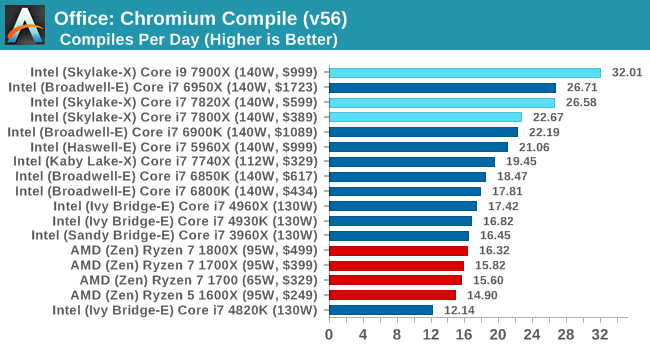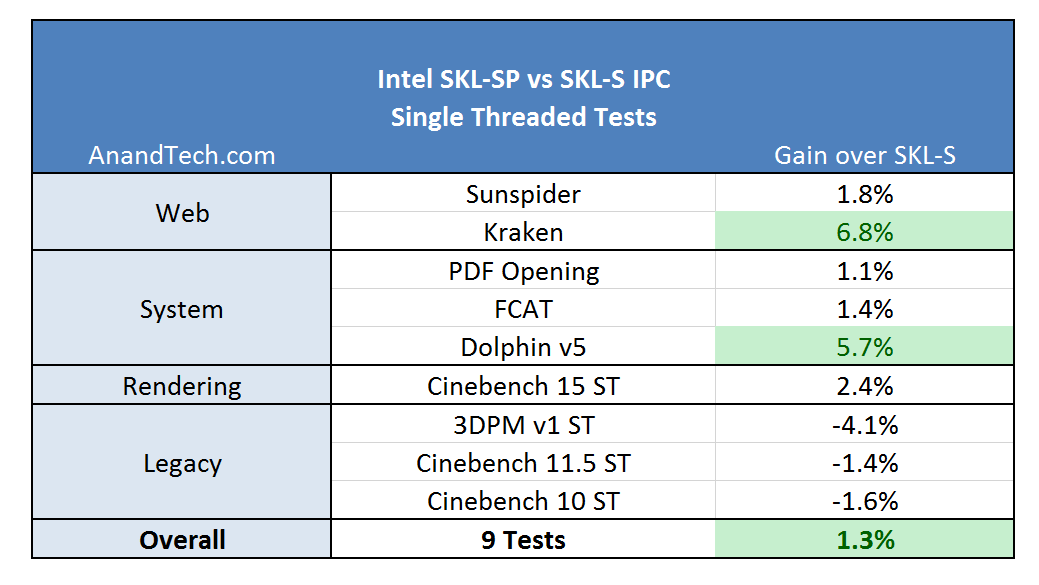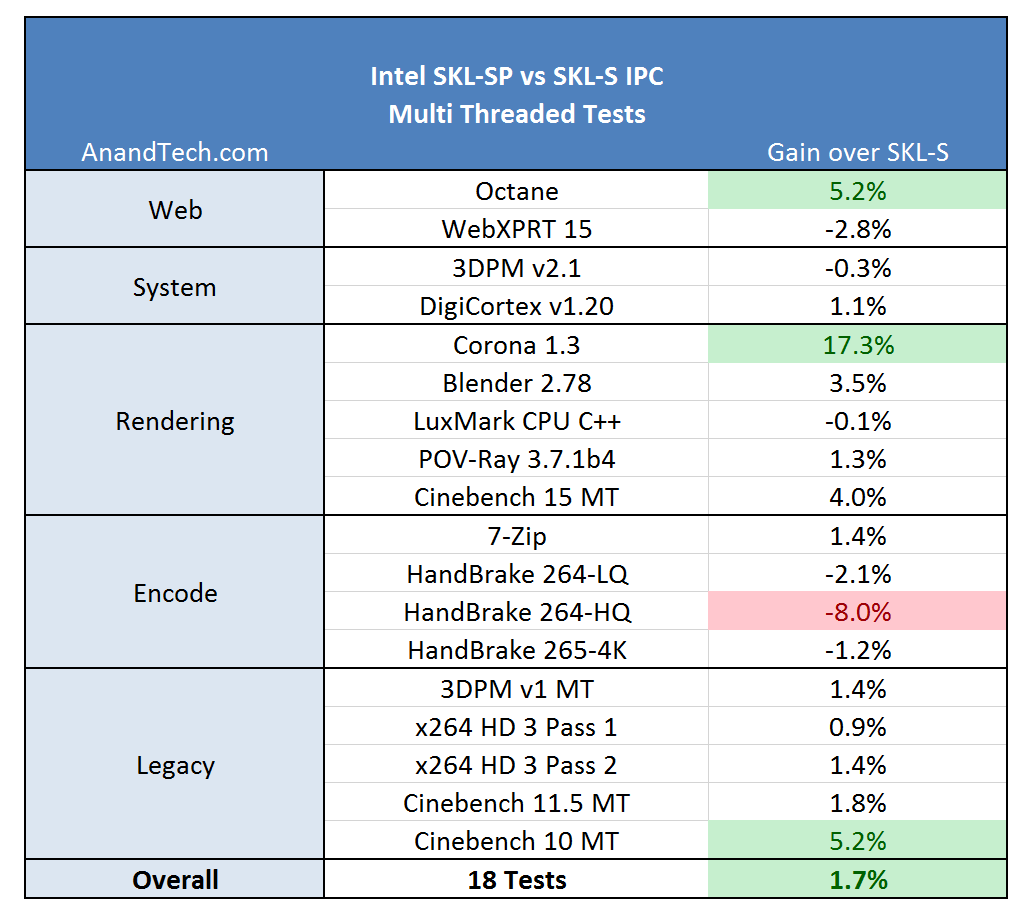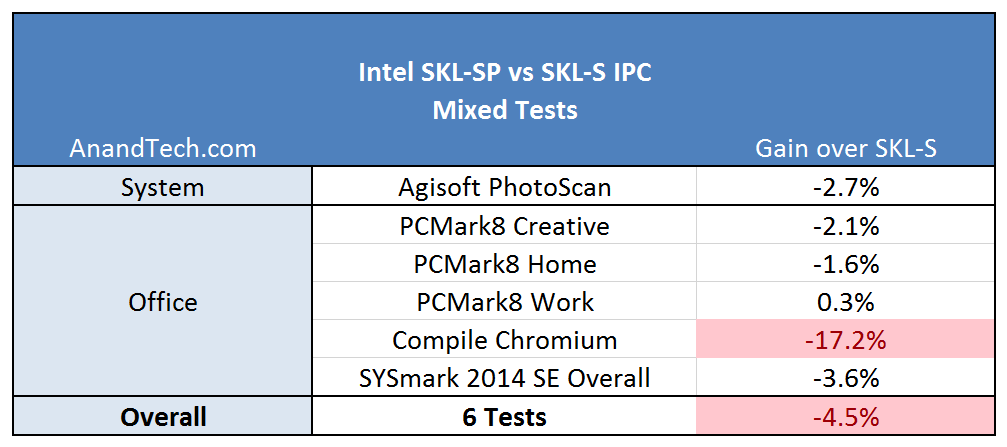The Intel Skylake-X Review: Core i9 7900X, i7 7820X and i7 7800X Tested
by Ian Cutress on June 19, 2017 9:01 AM ESTComparing Skylake-S and Skylake-X/SP Performance Clock-for-Clock
If you’ve read through the full review up to this point (and kudos), there should be three things that stick in the back of your mind about the new Skylake-SP cores: Cache, Mesh and AVX512. These are the three main features that separate the consumer grade Skylake-S core from this new core, and all three can have an impact in clock-for-clock performance. Even though the Skylake-S and the Skylake-SP are not competing in the same markets, it is still poignant to gather how much the changes affect the regular benchmark suite.
For this test, we took the Skylake-S based Core i5-6600 and the Skylake-SP based Core i9-7900X and ran them both with only 4 cores, no hyperthreading, and 3 GHz on all cores with no Turbo active. Both CPUs were run in high performance modes in the OS to restrict any time-to-idle, so it is worth noting here that we are not measuring power. This is just raw throughput.
Both of these cores support different DRAM frequencies, however: the i5-6600 lists DDR4-2133 as its maximum supported frequency, whereas the i9-7900X will run at DDR4-2400 at 2DPC. I queried a few colleagues as to what I should do here – technically the memory support is an extended element of the microarchitecture, and the caches/uncore/untile will be running at different frequencies, so how much of the system support should be chipped away for parity. The general consensus was to test with the supported frequencies, given this is how the parts ship.
For this analysis, each test was broken down in two ways: what sort of benchmark (single thread, multi-thread, mixed) and what category of benchmark (web, office, encode).
For the single threaded tests, results were generally positive. Kraken enjoyed the L2, and Dolphin emulation had a good gain as well. The legacy tests did not fair that great: 3DPM v1 has false sharing, which is likely taking a hit due to the increased L2 latency.
On the multithreaded tests, the big winner here was Corona. Corona is a high-performance renderer for Autodesk 3ds Max, showing that the larger L2 does a good job with its code base. The step back was in Handbrake – our testing does not implement any AVX512 code, but the L3 victim cache might be at play here over the L3 inclusive cache in SKL-S.
The mixed results are surprising: these tests vary with ST and MT parts to their computation, some being cache sensitive as well. The big outlier here is the compile test, indicating that the Skylake-SP might not be (clock for clock) a great compilation core. This is a result we can trace back to the L3 again, being a smaller non-inclusive cache. In our results database, we can see similar results when comparing a Ryzen 7 1700X, an 8-core 95W CPU with 16MB of L3 victim cache, is easily beaten by a Core i7-7700T, with 4 cores at 35W but has 8MB of inclusive L3 cache.
If we treat each of these tests with equal weighting, the overall result will offer a +0.5% gain to the new Skylake-SP core, which is with the margin of error. Nothing too much to be concerned about for most users (except perhaps people who compile all day), although again, these two cores are not in chips that directly compete. The 10-core SKL-SP chip still does the business on compiling:

If all these changes (minus AVX512) offer a +0.5% gain over the standard Skylake-S core, then one question worth asking is what was the point? The answer is usually simple, and I suspect involves scaling (moving to chips with more cores), but also customer related. Intel’s big money comes from the enterprise, and no doubt some of Intel’s internal metrics (as well as customer requests) point to a sizeable chunk of enterprise compute being L2 size limited. I’ll be looking forward to Johan’s review on the enterprise side when the time comes.













264 Comments
View All Comments
Ian Cutress - Monday, June 19, 2017 - link
We didn't post gaming data in our launch Ryzen 7 review for the same reason. You are applying double standards.http://www.anandtech.com/show/11170/the-amd-zen-an...
melgross - Monday, June 19, 2017 - link
Man, another guy who didn't actually read the article, but reads other poster's remarks who also didn't read the article. Can't we just deleted these jerks remarks?koomba - Thursday, July 6, 2017 - link
Please go back and tag my reply on page 7. Short version: you are wrong, they did NOT do gaming benchmarks on their launch Ryzen review either.So quit whining about something that DIDN'T HAPPEN and using it as a weak excuse to bash this site. Your blatant AMD fan boy agenda is pathetic.
nicolaim - Monday, June 19, 2017 - link
Typos. Second table on first page says i7 instead of i9.nicolaim - Monday, June 19, 2017 - link
And incorrect MSRP for Ryzen 7 1800X.Ryan Smith - Monday, June 19, 2017 - link
Please be sure to reload. Both of those issues on the first page were corrected some time ago.Bulat Ziganshin - Monday, June 19, 2017 - link
I have predicted details of AVX-512 implementation 1.5 years ago when SKL-S microarchitecture was described in Intel optimization manual. These are details:http://www.agner.org/optimize/blog/read.php?i=415#...
Einy0 - Monday, June 19, 2017 - link
Very disappointed that AT did not publish game benchmarks because they didn't show Intel in the best light but had no problem making a big deal about Ryzen's gaming issues. This isn't the brand of journalism that Anand built this site on. It's certainly not what attracted me to the site and has had me coming back for 20 years. I come for unbiased straight shooting PC technology reviews. Now we get a mobile focus and biased PC hardware reviews. Not to mention the full screen popup ads and annoying hover ads that refuse to go away. How far the mighty have fallen!Ian Cutress - Monday, June 19, 2017 - link
We never posted Ryzen 7 gaming benchmarks in our launch review for the same reason. Please go back and check:http://www.anandtech.com/show/11170/the-amd-zen-an...
melgross - Monday, June 19, 2017 - link
You know, it almost doesn't pay to respond to these guys. They're AMD fanboys who are too lazy to read the article first, and they won't read your link either, because they don't want to. They want to believe what they say, no matter what.